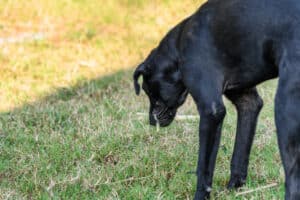
Rat fleas are primary carriers of nasty diseases like the bubonic plague and murine typhus.
©Yale Peabody Museum (Daniel J. Drew), CC0, via Wikimedia Commons – Original / License
Fleas are a natural blight on the world. Dog owners must always be on the lookout after a walk just in case their pet picks up one of these unwanted hitchhikers. They are difficult to remove from the house and can be stressful to clean off a dog. If one or two fleas survive a de-bugging, then they will reproduce and infest the house all over again.
Thankfully, there are several natural methods for eliminating the threat of these pests. Specific flower scents and modern hygienic sprays, coupled with herbal fragrances, are capable of eliminating these insects before they completely infest your home.
Stop using harsh chemicals on your dog and try one of these natural methods for removing fleas from your pooch.
Why Are Fleas Dangerous
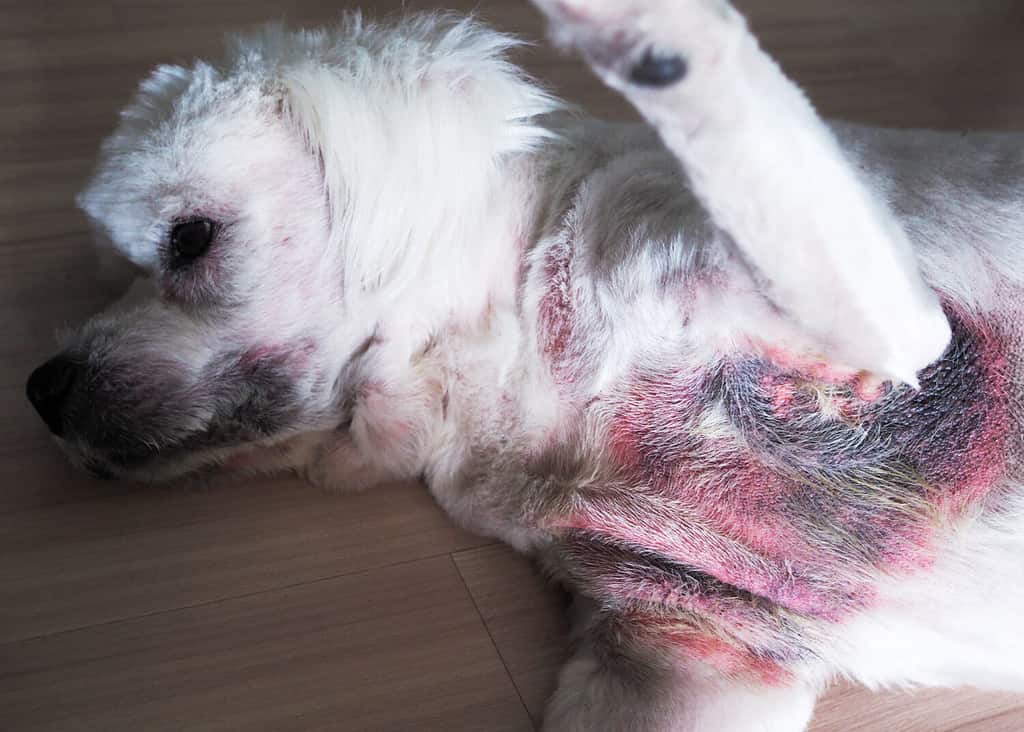
Dogs can experience different types of allergic reactions from flea bites.
©Kittima05/Shutterstock.com
Everyone knows fleas are nothing but a burden. They spread diseases like the black plague or animal-specific diseases. However, they contribute to population control. Fleas are nature’s way of ensuring animals like deer, rabbits, and other small animals do not overpopulate.
Dogs are sensitive to flea bites, which lead to several health-related problems:
- Allergic reactions
- Hair loss
- Skin inflammation
- Weakened immune system
- Tapeworms
- Anemia
- Bartonella infections
Dogs should be immediately treated for fleas the moment they are detected.
How Do Dogs Get Fleas
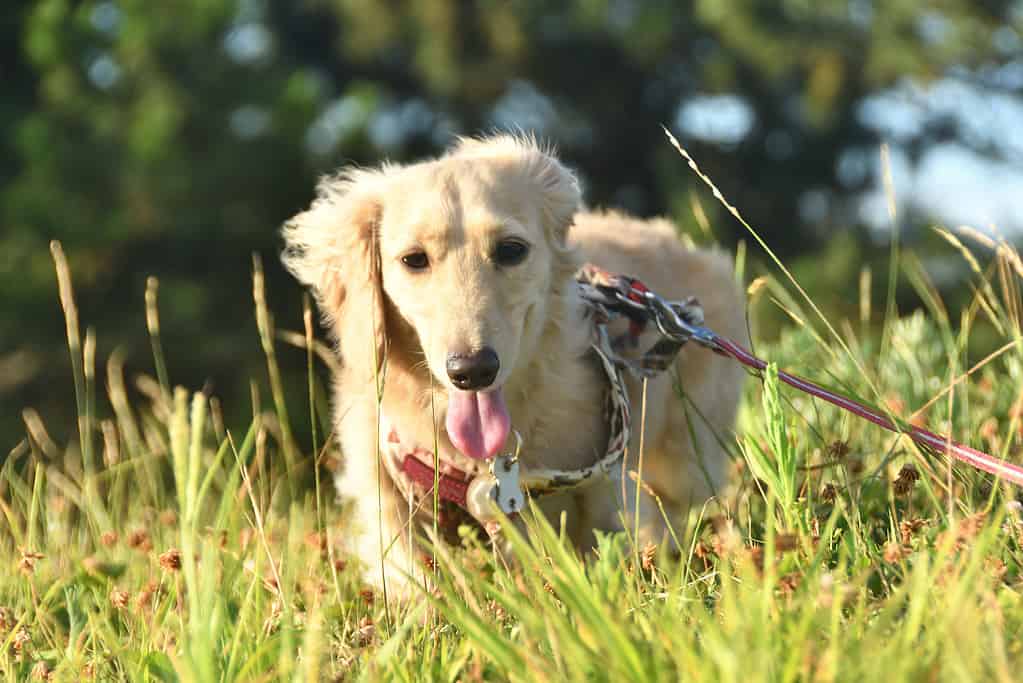
Dogs and humans accidentally pick up fleas in tall grass, which are then brought home.
©Yata/iStock via Getty Images
Fleas are expert climbers and jumpers, capable of clinging onto animals as they pass by in tall grass. They latch onto whatever comes in their path, sucking blood from their new host and laying eggs.
Dogs are highly susceptible to fleas by:
- Walking in tall grass
- Being near other pets with fleas
- Being in a house with fleas and carrying them home
- Kennels, groomers, or veterinary clinics that are not properly sanitized
Veterinary clinics, dog kennels, and groomers have protocols in place when a dog has fleas. Many places will close off the room and disinfect everything from top to bottom, ensuring no fleas or flea eggs pass from one patient to another.
Fleas can survive the cold weather in winter, making them a year-long problem.
Methods of Removing Fleas Naturally from Dogs
Some medication-sensitive dogs have experienced adverse side effects from modern medications. People are looking for alternative options to toxic chemicals. Thankfully, natural flea and tick remedies are abundant, as humans have been combating these pests for thousands of years.
Natural Flea Sprays
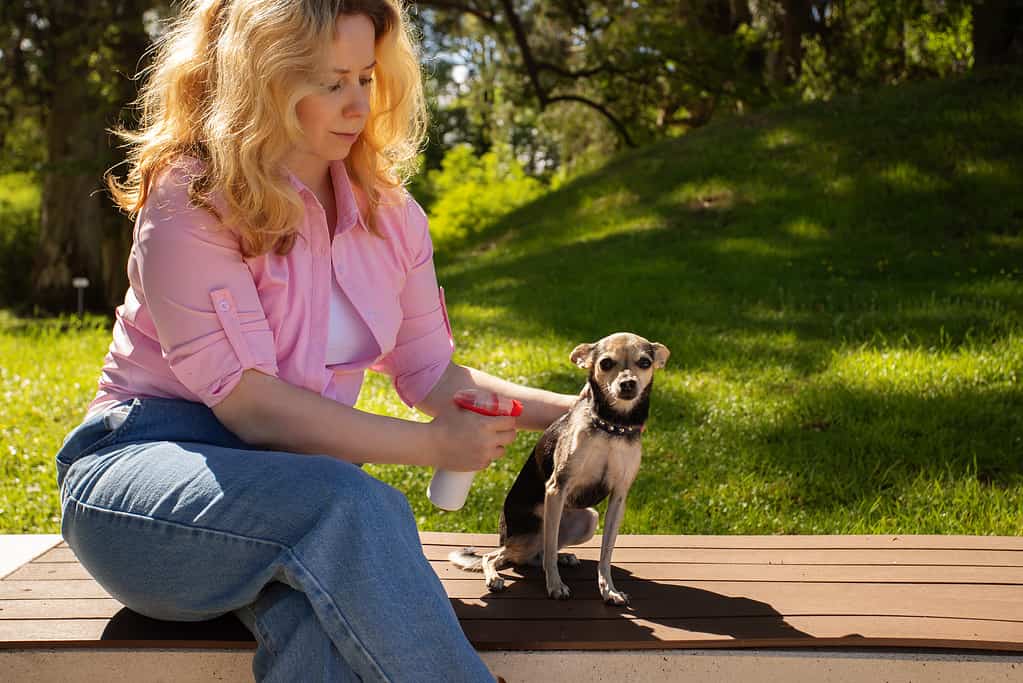
Flea sprays with natural ingredients are gentle and reduce risk of adverse side effects.
©Yana Tikhonova/iStock via Getty Images
Natural flea sprays are chemical-free and found at holistic integrative veterinary clinics and pet stores. These sprays use safe and gentle water-based solvents to safely kill fleas and eggs.
Application
Spray the dog’s entire body with natural flea sprays. Then, put on a pair of gloves and brush the dog’s coat. The spray is safe for human skin, but the gloves are used to prevent fleas from leaping onto the owner. Massage the solvent into the dog’s fur, making sure it reaches the skin and undercoat (if applicable). After waiting the allotted time according to the bottle or veterinarian’s instructions, use a flea comb to brush out any remaining dead fleas.
Coconut Oil

Dogs try to lick the coconut oil from their paws and skin. Only use small amounts at a time.
©ThamKC/Shutterstock.com
Coconut oil is a healthy and safe alternative for flea eradication. Placing the oil on the dog will suffocate the fleas, preventing them from moving, spreading, or laying eggs. Coconut oil is available online, at veterinarian offices, and at natural pet boutique stores and salons.
Application
Take your dog outside on a hard surface like a porch or driveway. Secure him in place so he doesn’t run away.
Massage small amounts of coconut oil in the dog’s coat, ensuring it reaches the skin and undercoat (if applicable). The oil will suffocate fleas it comes in contact with, while forcing nearby fleas to abandon the dog. Fleas like to congregate on a dog’s ears, neck, legs, and hindquarters. Focus on those areas and gently brush the oil through the coat to deter other fleas from staying.
Essential Oils

All natural essential oils are safe to place on pets, with some like lavender being an anti-lick deterrent.
©leonori/iStock via Getty Images
Essential oils and aromatherapy are a natural and historically easy way of deterring fleas and other annoying insects like ticks and mosquitos. Fleas hate the smell of overpowering citric-scented aromas.
Excellent essential oils that deter fleas are:
- Lavender
- Cedarwood
- Citronella
- Lemongrass
- Peppermint
- Rosemary
- Eucalyptus oil
Application
These oils can be administered topically in small drops or sprays across the dog’s body.
Topical Use
Place several small drops along the dog’s back. Wearing a glove, massage the oil into the dog’s coat, ensuring it reaches the skin and undercoat (if applicable). The fleas will abandon the dog, seeing it as an inappropriate host.
Spray
Fill the glass spray bottle with clean water. Then, add several drops of the essential oil of your choosing and shake. Spray your dog and brush the coat with a slicker brush to help spread the oil to the skin. The ratio of water to essential oil will vary depending on the size of the dog, the dog’s sensitivity to scents, and the level of infestation.
As a bonus, several essential oil blends have a pleasant fragrance, making your dog smell nice and earthy.
Organic Flea Treatment Shampoos

Flea shampoos and a few essential oil drops can be used together for extra strength anti-flea support.
©Srdjanns74/iStock via Getty Images
Organic flea shampoos are a two-fold method of removing fleas from dogs and making them smell fresh and clean. Normal soap and water can kill most fleas, but organic flea shampoos use natural ingredients to target and remove fleas and eggs.
Application
Different organic flea shampoos have varying instructions depending on the size of the dog. Typically, using organic flea shampoos is similar to bathing a dog with regular shampoo. First, rinse the coat with water. Then, add the flea shampoo and lather it into the dog’s coat, focusing on high flea-infested areas like the neck, legs, and back. Finally, rinse off the shampoo and repeat if necessary.
Avoid getting water in the dog’s eyes and ears. Too much moisture in the ears will cause ear infections, which will require medical treatment.
Apple Cider – Vinegar Spray

Speak with a veterinarian regarding how much apple cider vinegar to use with dogs.
©focal point/Shutterstock.com
Apple cider vinegar is a common home remedy for flea infestations. The scent of apple cider is strong and intolerable to fleas. Alternatively, you can use orange or lemon-scented ciders as a possible solution.
Pet parents should consult a veterinarian regarding the amount of vinegar to use. Too much vinegar will overwhelm the dog and make her sick if ingested. Too little vinegar may not be effective.
Soap and Water
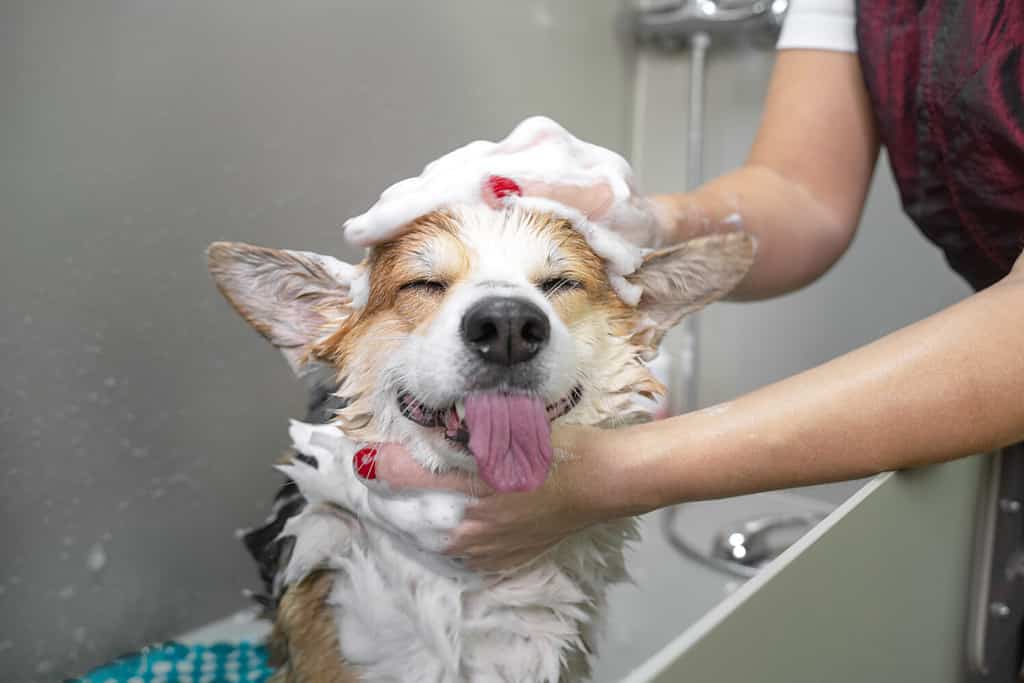
Regular pet safe soap and water can be used to effectively remove fleas and ticks from the coat.
©Masarik/Shutterstock.com
A simple method to remove fleas is traditional soap and water. Diluted dish soap and water will kill fleas while cleaning the dog. Normal dish soaps are very strong with heavy chemicals, so it is better to use pet-safe soaps.
Application
First, spray the dog down with warm water in a bathtub or dog pool outside. Standing water will catch and drown fleas trying to escape the bath. Lather the dog in the soapy water, ensuring it reaches beneath the undercoat and contacts the skin. Rinse the soap out of the coat and repeat two or three times, depending on the instructions on the bottle. After, dry the dog and brush with a flea comb to make sure all fleas are gone.
Removing Fleas from Home

Flea eggs can embed themselves in the carpet, making them difficult to remove if not attentive.
©Paolo Cordoni/iStock via Getty Images
A flea-infested dog will spread fleas wherever he goes: the couch, the bed, on clothes, in the yard, and on the carpet. To effectively keep fleas off your pup, the house must be clear of fleas.
Methods for removing fleas from the home are:
- Vacuum the entire house. Clean every floor, corner, and step.
- Flea bomb the house with appropriate pet-safe flea removal powders.
- Sprinkle Diatomaceous Earth, a natural anti-flea powder, on carpets and furniture to kill flea eggs.
- Baking soda is a safe cleaning powder that kills fleas and eggs. Use a hard scrubbing brush to kill flea eggs embedded in fabric, furniture, and carpets.
- Wash all clothing and bedding the dog has touched.
- Treat the backyard with aroma essences like essential oils or use pet-safe yard flea eradicators.
Preventing Fleas from Infesting Dogs

Check dogs for fleas by using a flea comb after hiking in the woods or walking in tall grass.
©olgamarc/iStock via Getty Images
Prevention is the best way to keep dogs safe from fleas. Dogs will not get fleas if pet parents pay attention and follow several appropriate steps.
- Use natural flea prevention sprays or essential oils to deter fleas from leaping onto your dog.
- Use a flea comb and brush the dog’s coat after every walk. Check for signs of fleas or ticks and remove them immediately.
- Brush the dog’s coat regularly. Brushing the coat is good for skin health, promotes bonding, and allows owners to check the skin for fleas at the end of the day.
- Buy and use natural flea collars that have essential oil scents or sound-modulating technology to deter fleas and ticks.
Hazards of Modern Chemicals on Dogs
Certain dogs like Akitas and Australian shepherds are sensitive to chemicals. They are at higher risk of allergic reactions when given vaccinations or topical medications like flea and tick repellants.
Pet parents should stop using the medication and immediately see a veterinary professional if their dog exhibits:
- Vomiting and diarrhea
- Excessive drooling
- Lethargy
- Skin irritation and inflammation
- Tremors or seizures
Drooling is a common symptom, but tremors and seizures are severe and must be immediately treated.
Fleas are an eternal nuisance for pet parents. It is common for dogs to experience fleas once in their life because fleas are a natural part of the ecosystem. They provide a valuable service to the world through population control. However, they do not need to pester our pets with their blood-sucking diseases. Pet parents should always be prepared in case their dog is infested with fleas.
Thank you for reading! Have some feedback for us? Contact the AZ Animals editorial team.






